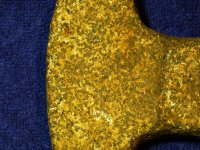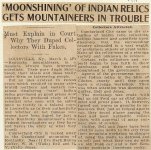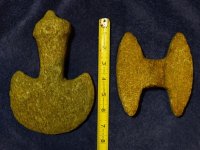Upvote
0
Navigation
Install the app
How to install the app on iOS
Follow along with the video below to see how to install our site as a web app on your home screen.
Note: This feature may not be available in some browsers.
More options
You are using an out of date browser. It may not display this or other websites correctly.
You should upgrade or use an alternative browser.
You should upgrade or use an alternative browser.
Identify these artifacts
- Thread starter rocke
- Start date
Charl
Silver Member
The butterfly form would be a banner preform. But, I would have those looked at before deciding if they were genuine or modern.
Seadog72
Jr. Member
Charl, I was thinking the same for the butterfly.
Rocke,
There are professional archeologists and Lithics experts on here much more qualified than I am to answer your question but since none of them has responded yet I will tell you my thoughts.
It would help to know precisely or approximately where they were found. Lacking that, everything is an educated or opinionated guess. The lunate piece (on the left) doesn't match anything that I've seen in private collections or museums. It appears similarly shaped to a barbed axe but it is not polished and being made of what appears to be granite I would think it was either unfinished or something unknown (at least to me). I saw a piece similar to it in Buckland, Virginia but your piece is much fancier.
Atlatl's, or spindle weights depending on your preference, are very common finds where I live. Maybe yours is an intriquite bar weight? Perhaps a birdstone or boatstone or even a loafstone. Also, it could be an unfinished bannerstone but by definition, not a bannerstone by the lacking of convex features it was not a bannerstone in the making. In the 40's during an excavation in Ipiutak, Alaska something similar to the butterfly shaped stone was found but once again your image is in a class all it's own from what I've seen.
Could these be casts or reproductions?
Don't worry, friend. I'm sure an expert will be along shortly to correctly identify these. They look very interesting and if I found them I would sure be asking questions.
-Seadog
Rocke,
There are professional archeologists and Lithics experts on here much more qualified than I am to answer your question but since none of them has responded yet I will tell you my thoughts.
It would help to know precisely or approximately where they were found. Lacking that, everything is an educated or opinionated guess. The lunate piece (on the left) doesn't match anything that I've seen in private collections or museums. It appears similarly shaped to a barbed axe but it is not polished and being made of what appears to be granite I would think it was either unfinished or something unknown (at least to me). I saw a piece similar to it in Buckland, Virginia but your piece is much fancier.
Atlatl's, or spindle weights depending on your preference, are very common finds where I live. Maybe yours is an intriquite bar weight? Perhaps a birdstone or boatstone or even a loafstone. Also, it could be an unfinished bannerstone but by definition, not a bannerstone by the lacking of convex features it was not a bannerstone in the making. In the 40's during an excavation in Ipiutak, Alaska something similar to the butterfly shaped stone was found but once again your image is in a class all it's own from what I've seen.
Could these be casts or reproductions?
Don't worry, friend. I'm sure an expert will be along shortly to correctly identify these. They look very interesting and if I found them I would sure be asking questions.
-Seadog
- Thread starter
- #4
Charl, I was thinking the same for the butterfly.
Rocke,
There are professional archeologists and Lithics experts on here much more qualified than I am to answer your question but since none of them has responded yet I will tell you my thoughts.
It would help to know precisely or approximately where they were found. Lacking that, everything is an educated or opinionated guess. The lunate piece (on the left) doesn't match anything that I've seen in private collections or museums. It appears similarly shaped to a barbed axe but it is not polished and being made of what appears to be granite I would think it was either unfinished or something unknown (at least to me). I saw a piece similar to it in Buckland, Virginia but your piece is much fancier.
Atlatl's, or spindle weights depending on your preference, are very common finds where I live. Maybe yours is an intriquite bar weight? Perhaps a birdstone or boatstone or even a loafstone. Also, it could be an unfinished bannerstone but by definition, not a bannerstone by the lacking of convex features it was not a bannerstone in the making. In the 40's during an excavation in Ipiutak, Alaska something similar to the butterfly shaped stone was found but once again your image is in a class all it's own from what I've seen.
Could these be casts or reproductions?
Don't worry, friend. I'm sure an expert will be along shortly to correctly identify these. They look very interesting and if I found them I would sure be asking questions.
-Seadog
Wow, thanks for all the info. This forum is an unbelievable resource. I have attached a close-up of each object below.
Both pieces are very rough and do appear to be unfinished. The crescent piece reminds me of the kind of stone I've seen a lot of in western North Carolina. It has very small mica flakes in it which gives it a sparkling appearance. While I am absolutely a newbie to all of this, the butterfly piece appears to have peck marks from the forming of the object.
Neither piece is a casting. They are both made from stone.
The pieces were given to me in the 1950's from a family member that bought a collection of Indian artifacts in the late 1920's in Cherokee, NC.


Seadog72
Jr. Member
Somebody on here is an expert on these pieces. It takes time but you'll get a lot of good feedback. I went to the Cherokee Indian Museum south of Gatlinburg in the mid 90's but they only had one Lithic piece, it was a reproduction and for sale, so I do not imagine it's changed much. Really cool pieces! Looking forward to what the experts have to say.
joshuaream
Silver Member
These two pieces look like reproductions to me just based on the form and materials. The butterfly piece is an attempt at a winged bannerstone from Illinois, Iowa or Wisconsin commonly called a bowtie bannerstone. It is made from a right type of material (granite/gneiss) and has the squared off mid section, but the angles on the wings and size/thickness is way off. The other piece looks like an attempt at a spud/spatulate form, but the material and handle are wrong for the type. It might be something international, but I'd guess a replica.
Mark Hannah Guffey from Kentucky was a dealer who advertised heavily back in the 1920's and 1930's, he made and sold thousands of pieces like these. The banner very well could be his work.
Mark Hannah Guffey from Kentucky was a dealer who advertised heavily back in the 1920's and 1930's, he made and sold thousands of pieces like these. The banner very well could be his work.
- Thread starter
- #7
These two pieces look like reproductions to me just based on the form and materials. The butterfly piece is an attempt at a winged bannerstone from Illinois, Iowa or Wisconsin commonly called a bowtie bannerstone. It is made from a right type of material (granite/gneiss) and has the squared off mid section, but the angles on the wings and size/thickness is way off. The other piece looks like an attempt at a spud/spatulate form, but the material and handle are wrong for the type. It might be something international, but I'd guess a replica.
Mark Hannah Guffey from Kentucky was a dealer who advertised heavily back in the 1920's and 1930's, he made and sold thousands of pieces like these. The banner very well could be his work.
Wow, thanks for the heads-up on this. I was just assuming that since they were purchased in the late 1920's, they would be authentic but certainly we have been reproducing antiquated styles forever in the US, from jewelry to furniture so why not Indian artifacts back then. Now, that calls into question several of the other pieces I have been asking about in other threads.
In form, I had wonder if the butterfly piece might have been an incomplete bannerstone but appeared to be much to large/heavy. I also wonder if the other one might have been a spud/spatulate form, but again this one seemed much larger than the ones I had seen elsewhere.
I'll have to see what I can find on Guffey. Thanks!
Update! Looked up Guffey and found a newspaper clip from a 1929 newspaper that talked about making reproductions in Kentucky that were so authentic that they might be found in many collections and museum. Now, is there a market for his pieces if there was some way to tell. Boy, this is all getting much more complicated that I ever anticipated.
Last edited:
rocky ALLETI
Tenderfoot
- Jul 13, 2014
- 5
- 2
- Detector(s) used
- Garrett AT pro
- Primary Interest:
- All Treasure Hunting
Rocke, I have been into Indian Artifacts for over 35 years and both pcs are not made right. The pc on the left resemble a hardstone spud but here in America have never had a knobbed haft, bad reproduction. The one on the right looks like a Constricted Center Gorget from The Glacier Kame Culture usually made from banded slate and some cannel coal but also a modern reproduction. Material for both are wrong. Just my opinion. Rocky Falleti
- Thread starter
- #10
Thanks for your perspective. I certainly have not been able to find anything on them. Again, if they are reproductions, it would be from the 1920's and as someone pointed out, there were people doing reproductions even during that time.
The Grim Reaper
Gold Member
I have to agree with Joshua. Those look like typical poorly made reproductions to me.
- Thread starter
- #12
These two pieces look like reproductions to me just based on the form and materials. The butterfly piece is an attempt at a winged bannerstone from Illinois, Iowa or Wisconsin commonly called a bowtie bannerstone. It is made from a right type of material (granite/gneiss) and has the squared off mid section, but the angles on the wings and size/thickness is way off. The other piece looks like an attempt at a spud/spatulate form, but the material and handle are wrong for the type. It might be something international, but I'd guess a replica.
Mark Hannah Guffey from Kentucky was a dealer who advertised heavily back in the 1920's and 1930's, he made and sold thousands of pieces like these. The banner very well could be his work.
Here is the piece on Guffey. It certainly is the right time period being that the collection was purchased in 1925-26 in Cherokee, NC.

Top Member Reactions
-
 3556
3556 -
 1972
1972 -
 1820
1820 -
 1201
1201 -
 1136
1136 -
 1011
1011 -
 883
883 -
 855
855 -
 817
817 -
 795
795 -
 742
742 -
 666
666 -
 577
577 -
 566
566 -
 502
502 -
 467
467 -
 422
422 -
E
416
-
 405
405 -
 399
399
Users who are viewing this thread
Total: 2 (members: 0, guests: 2)








